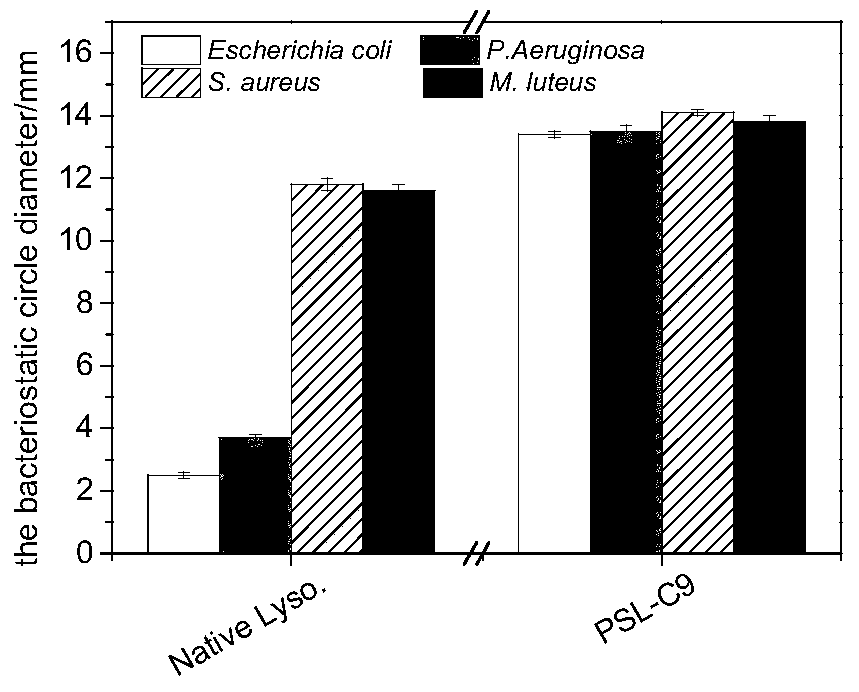A kind of lysozyme covalently modified by short aliphatic chain sophorolipid derivatives and its modification method and application
A chain sophorolipid and modification method technology, which is applied in the field of food preservation, can solve the problems of inability to effectively inhibit the activity, difficult to dissolve, limit the application range of lysozyme, etc., and the method is simple and flexible, with little loss of enzyme activity, The effect of expanding the antibacterial spectrum
- Summary
- Abstract
- Description
- Claims
- Application Information
AI Technical Summary
Problems solved by technology
Method used
Image
Examples
Embodiment 1
[0039] The preparation method of carboxylic acid type short aliphatic chain sophorolipid derivatives (PSL-C9):
[0040] (1) Add 29.80g (43.27mmol, 1eq) sophorolipids, 50mL dry methanol and 1.62mL (6.49mmol, 0.15eq) sodium methoxide, CaCl to a 100mL round bottom flask sequentially 2 Protect, heat to reflux for 3 hours, lower to room temperature, adjust pH to neutral with acid, remove solvent under reduced pressure, dissolve in deionized water, and place in ice bath at 0°C until powder precipitates, filter, wash with water, and dry under reduced pressure to obtain the product 22.5 g (82%).
[0041] (2) 21.56g (33.86mmol, 1eq) of step (1) product, 50mL of absolute dry organic solvent THF, 25.4mL (270.84mmol, 8eq) of acetic anhydride and 1.654g (13.54mmol, 0.4eq) DMAP, stirred at room temperature for 1h, CaCl 2 Protected, dissolved in ethyl acetate after removing the solvent under reduced pressure, and using saturated NaHCO 3 Wash the mixture 3 times with the solution, recover ...
Embodiment 2
[0045] Covalent modification of natural egg white lysozyme by carboxylic acid type short aliphatic chain sophorolipid derivative (PSL-C9):
[0046] 1) Dissolve the N-hydroxysuccinimide ester of the carboxylic acid type short aliphatic chain sophorolipid derivative (PSL-C9) in 5mL DMSO to form a solution with a final concentration of 0.7mM, and add 25mL dropwise while stirring, 0.2mM, 1% NaHCO 3 The egg white lysozyme solution was stirred slowly and reacted at 30°C for 6h. After the reaction, add 25mL of 100mM glycine solution to the system, keep the temperature at 30°C for 10min, dialyze with deionized water at room temperature, then dialyze with 20mM phosphate buffer, pH 7.0, and maintain at 4°C for about 1 day. In order to remove unreacted acid-type peracetyl sophorolipids, the dialyzate was centrifuged at 12,000 rpm at 5°C for 10 min, and the suspension was collected as a seed.
[0047] 2) Determination of lysozyme activity:
[0048] Place the enzyme solution to be teste...
Embodiment 3
[0050] Determination of the inhibition zone: using the cup and saucer method. Take 20mL of melted solid culture-based culture dish, after solidification, take 0.2mL with a concentration of 10 6 -10 7 Each bacterial suspension of CFU / mL was evenly spread in the solid medium, and after 10 minutes, the Oxford cup was placed on the surface of the petri dish, the sample solution was added, the medium was covered, and cultured at a constant temperature of 37°C for 24 hours, and the inhibition zone was measured. diameter. Each sample solution experiment was repeated 3 times, and the average value was taken.
PUM
 Login to View More
Login to View More Abstract
Description
Claims
Application Information
 Login to View More
Login to View More - R&D
- Intellectual Property
- Life Sciences
- Materials
- Tech Scout
- Unparalleled Data Quality
- Higher Quality Content
- 60% Fewer Hallucinations
Browse by: Latest US Patents, China's latest patents, Technical Efficacy Thesaurus, Application Domain, Technology Topic, Popular Technical Reports.
© 2025 PatSnap. All rights reserved.Legal|Privacy policy|Modern Slavery Act Transparency Statement|Sitemap|About US| Contact US: help@patsnap.com



